Bagar tract
Bagar (बागड़), a term meaning the "dry country",[1] refers to the sandy tract of north-western India and eastern parts of current Pakistan bordering India.[2]
Bagri people
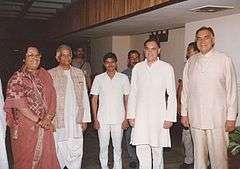
The term "Bagri people" was originally applied to the Hindu Jats and Rajputs, such as Bagri Jat and Bagri Rajput,[1][3][4][5][6][7][1][8] but now also applied to Bishnoi and one of the sections of Maheshwari Banias (traders), as well as Badhik ("butcher"), Pardhi ("hunter") and Bawariya (semi-nomads) castes.[4][7] Prominent bagri people include was politician from Haryana Mani Ram Bagri (1 January 1920 – 31 March 2012, a politician from Haryana), Raj Bagri, Baron Bagri (24 August 1930 – 26 April 2017, India-born British businessman and a Conservative member of the House of Lords from 1997 to 2010, who was made a life peer in 1997).[9]
Bagri language
"Bagri people" of the sandy dry "Bagar tract" speak the "Bagri language" (बागड़ी), a dialect of overlapping Rajasthani language, Haryanvi language and Punjabi language of the Indo-Aryan family, spoken by about five million speakers.[10][11]
Bagri region
"Bagri region" or tract is long strip of shifting sand dunes called tibba (टिब्बा) and finer lands between them called lal (लाळ ) sandy tract in along the western border of Haryana and eastern border of Rajasthan.[12]
The Bagar region has potentially very fertile alluvial soil interspersed with highly permeable very sandy tracts in several places with water table more than 100 feet below ground containing brackish water usually unfit for human consumption, where dust storms frequent during the warm summer months from April till the end of July when monsoon arrives. Previously the tract was solely based on the rain and irrigation was possible only in the small area of Bagar region in districts of Fatehabad, Sirsa, Hanumangarh and Sriganganagar where the season Ghaggar river flows. After the opening of Bhakra Nangal Dam canal system in 1963 as well as the earlier Western Yamuna Canal now irrigate most of Haryana including all of the Bagar region falling in Haryana on its western border. Opening of Indira Gandhi Canal in 1983 brought the water of Sutlej and Beas rivers to the fields of Rajasthan including its Bagar tract stabilizing the sand dunes and soil erosion by preventing the expansion of desert.[13]
In Haryana, it covers southern parts of Sirsa district, and western villages of Fatehabad, Hisar, Bhiwani and Charkhi Dadri districts.[10][11][12][12]
In Rajasthan, it covers parts of tehsils of Ganganagar; Bhadra, Nohar in Hanumangarh district; Taranagar tehsil in Churu district.[10][12]
In Punjab (India), bagar tract covers Fazilka district and southern villages of Muktsar district.[10][11][14]
In Punjab, Pakistan, Bagri as minor language is spoken in Bahawalpur and Bahawalnagar district, though these are not considered parts of Bagar tract.[10][11][15]
Gallery
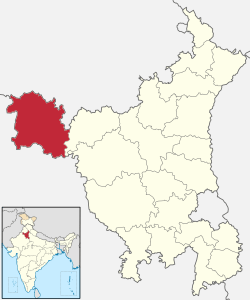
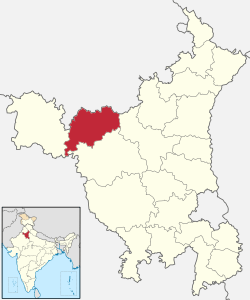
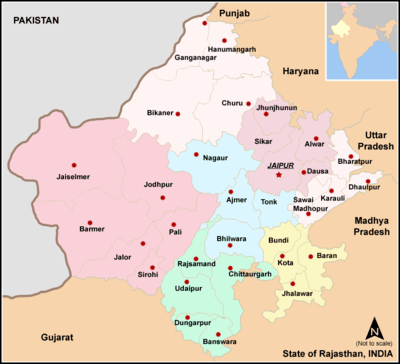 Bagar tract through eastern parts of Ganganagar district, Hanumangarh district, Churu district and Jhunjhunu district in Rajasthan
Bagar tract through eastern parts of Ganganagar district, Hanumangarh district, Churu district and Jhunjhunu district in Rajasthan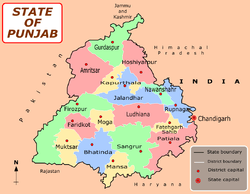 Bagar tract through Fazilka district (now a separate district, formerly southern part of Firozpur district) and southern villages of Muktsar district of Punjab (India)
Bagar tract through Fazilka district (now a separate district, formerly southern part of Firozpur district) and southern villages of Muktsar district of Punjab (India)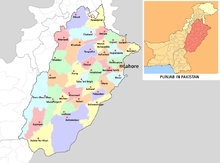 Bagri as minor language is spoken in Bahawalpur and Bahawalnagar district of Punjab, Pakistan, though not considered parts of Bagar tract.
Bagri as minor language is spoken in Bahawalpur and Bahawalnagar district of Punjab, Pakistan, though not considered parts of Bagar tract.
See also
References
- 1 2 3 Nonica Datta, "Forming an identity", The Tribune, 3 July 1999.
- ↑ Revised Land and Revenue Settlement of Hisar District 9006-9011
- ↑ Robert Vane Russell, 1916, "pt. II. Descriptive articles on the principal castes and tribes of the Central Provinces", page 435.
- 1 2 Robert Vane Russell, 1916, "The Tribes and Castes of the Central Provinces of India (Volumes I and II)", Library of Alexandria publication, ISBN 1465582940.
- ↑ B.S. Nijjar, 2008, "Origins and History of Jats and Other Allied Nomadic Tribes of India: 900 B.C.-1947 A.D.", Atlantic Publishers, page 51, ISBN 8126909080.
- ↑ 2000, "Haryana District Gazetteers: Rohtak district gazetteer, 1910", Government of Haryana Gazetteers organization, page 237.
- 1 2 Vīrasiṃha, 2006, "The Jats: Their Role & Contribution to the Socio-economic Life and Polity of North & North-west India, Volume 2", page 305, ISBN 8188629529.
- ↑ Nonica Datta, 1999, "Forming an Identity: A Social History of the Jats, Oxford University Press, page 12.
- ↑ Mosley, Charles, ed. (2003). Burke's Peerage, Baronetage & Knighthood (107 ed.). Burke's Peerage & Gentry. p. 219. ISBN 0-9711966-2-1.
- 1 2 3 4 5 Gusain, Lakhan: Reflexives in Bagri. Jawaharlal Nehru University, New Delhi, 1994
- 1 2 3 4 Gusain, Lakhan: Limitations of Literacy in Bagri. Nicholas Ostler & Blair Rudes (eds.). Endangered Languages and Literacy. Proceedings of the Fourth FEL Conference. University of North Carolina, Charlotte, 21–24 September 2000
- 1 2 3 4 India District Census Handboook, 1961
- ↑ E. Walter Coward, 1980, "Irrigation and Agricultural Development in Asia: Perspectives from the social sciences", Cornell University press, page 302, ISBN 0801498716.
- ↑ Census India 2001
- ↑ Gusain, Lakhan: Bagri Grammar. Munich: Lincom Europa (Languages of the World/Materials, 2000, p384